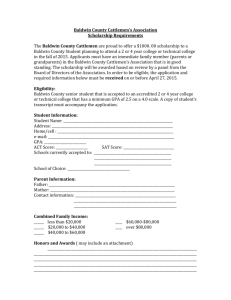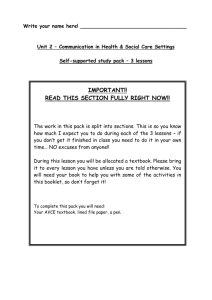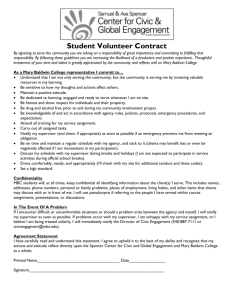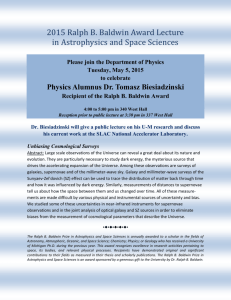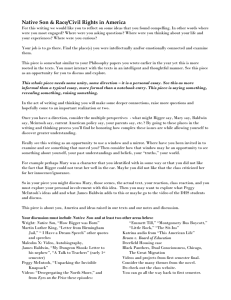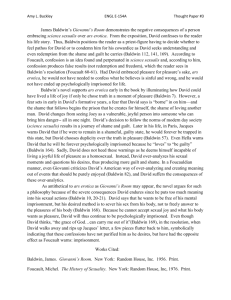History of Mechanical Computing Devices
advertisement
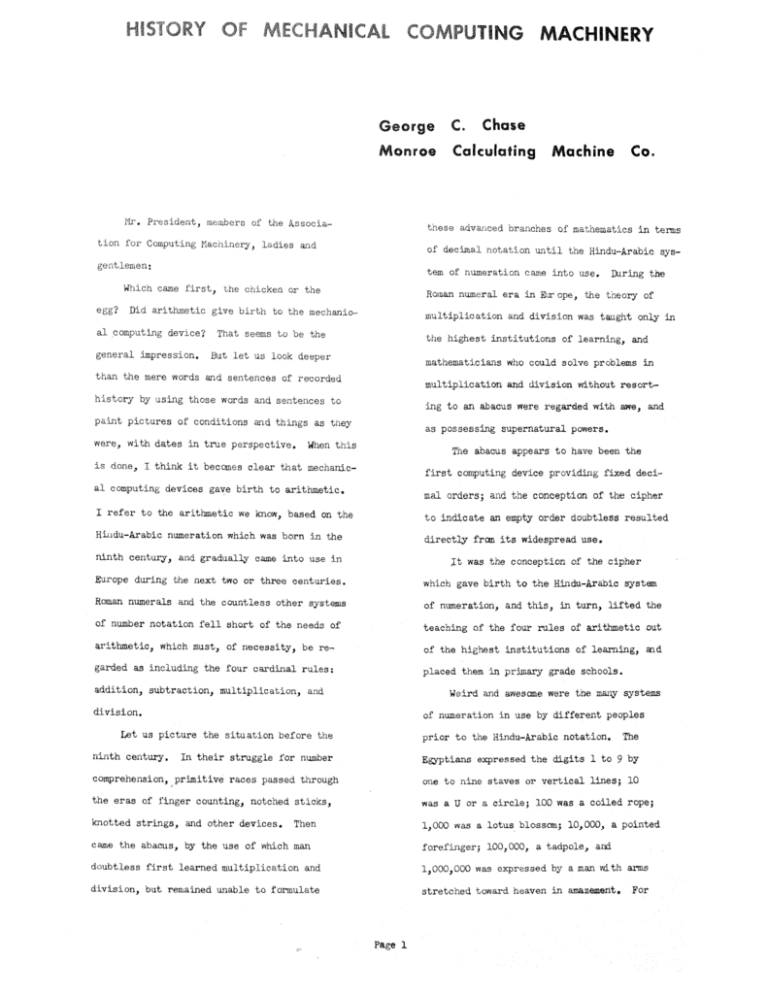
H STORY OF MECHANICAL COMPUTING MACHINERY
George
C.
Monroe
Calculating
i~. President, men,hers of the Associa-
came first, 5he chicken or the
Did arithmetic give birth to the mechanic~
al.computing device?
general impression.
than
tem o f numeration
came
R~aan
in ~r
numeral
era
into
ope,
use.
the
During
theory
the
of
multiplication and division was taught only ia
That seems to be the
the highest institutions of learning, and
But let us look deeper
mathematicians who could solve problems in
the mere words and sentences of recorded
multiplication and division without resort-
history by using those words and sentences to
ing to an abacus were regarded with awe, and
paint pictures of conditions and things as they
were, with dates in true perspective.
Co.
of decimal notation until the Hindu-Arabic sys-
gentlemen:
egg?
Machine
these advanced branches of mathematics in terms
tion for Computing Nachine~r~, ladies and
~ich
Chase
as possessing supernatural powers.
When this
The abacus appears to have been the
is done, I think it becomes clear that mechanic-
first computing device providLu~ fixed deci-
al computing devices gave birth to aritb~etico
mal orders; and the conception of the cipher
I refer to the arithmetic we know, based on the
to indicate an empty order doubtless resulted
Hh~du-Arabic numeration which was born in the
directly from its widespread use.
ninth century, and gradually came into use in
It was the conception of the cipher
~arope during the next two or three centuries.
which gave birth to the Hindu-Arabic system
Roman numerals and the countless other systems
of n~neration, and this, in turn, lifted the
of number notation fell short of the needs of
teaching of the four rules of ari~qmetic out
arithmetic, which must, of necessity, be re-
of the highest institutions of learning, aud
garded as including the four cardinal rules:
placed them in prSmary grade schools.
addition, subtraction, multiplication, and
Weird and awescme were the mmay systems
division.
of numeration in use by different peoples
Let us picture the situation before the
ninth century.
prior to the Hindu-Arabic notation.
In their struggle for number
The
Egyptians expressed the di@its 1 to 9 by
compreI~nsion, primitive races passed through
oue to nine staves or vertical lines; lO
the eras of finger counting, notched sticks,
was a U or a circle; leo was a coiled rope;
knotted strings, and other devices.
1,O00 was a lotus blosscm; lO, O00, a pointed
Then
came the abacus, by the use of which man
foref;huger; lOO,O00, a tadpole, a ~
doubtless first learned ~itiplication and
1,OO0,O00 was expressed by a man ~ith arms
division, but rema~led unable to f~.ulate
stretched ~oward heaven in amazement.
~
Page i
For
3,6~7,5~3, they had to show
listing" machines, such as the ~garroughs, and in
3 ~nazed men,
key-driven machines such as the Comptometer.
6 tadpoles,
While rotary actuators are inherently
4 pointed forefingers,
o~oable of making repeated cycles of registration
7 lotus blossoms,
more rapidly than reeiprocato~y actuators, the
5 coiled ropes,
rotary mechanimn does not lend itself readily to
4 hoops, and
the operation of prLnting values entered in the
3 staves.
machine, and totals.
Some of the earlier calculating machines,
I have a question.
How many men should be
such as the Grant and the Nercedes, which did
shown with arms outstretched toward heaven in
multiplication by repeated additions, wer@
s~azement at our national debt?
eq~ipped with reciprocatory actuators driven by
The history of mechanical computing
a rotary drive; and more recently, some of the
machinery in its essence is the story of the
reciprocatory actuator listing machines, such
numeral wheel, and the devices which rotate it
as the Remington, have been fitted with auto-
to register digital and tens-carry values.
matic controls which facilitate the operations
Ignoring zero-setting mechanism which
of ~ltiplication and division by repeated
clears the numeral wheels to zero after a calcu-
additive or subtractive registrations.
lation is cc~pleted, there are two fundamental
There has also been developed another
elements which rotate the numeral wheels:
species of numeral wheel actuating mechanism
1 - Digital value actuators which
rotate the wheels 1 to 9 steps to
register the digits 1 to 9;
which may be classified as partial product
actuating mechanism.
These devices do not require that ? shall
2 - Tens-carrying mechanisms which
advance or retract the next higher
order wheel as a given wheel passes
through ten units of registration.
be added six times to multiply 7 by 6, but provide for the turning of the lower of two adja-
The basic classification ~o be considered
cent numeral wheels two steps, or figures, and
relates to the digital value actuators which may
the higher wheel four steps, thereby register-
be divided into two major groups:
ing the partial product h2.
Such machines are
(a) Rotary digital actuators;
usually equipped with reciprocatory actuators.
(b) Reciprocatory digital actuators.
The Nillionaire calculating machine and the
We often speak of rotary or crank-type calculat-
Burroughs Noon-Hopkins billing machine are the
ing machines, referring specifically to the
best known of this species.
machines which perform multiplication and divi-
We are now ready to view some of the
sion by rapidly repeated cycles of operation.
machines and mechanisms which have played a
Evsn though motor-driven, such machines are still
major role in the history of mechanical com-
sometimes referred to as "crank-type machines .,,
puting machinery.
Reciproeatory digital actuators first came
into general use in the so-called "adding end
Page 2
2
i -
"A CHINAMAN STARTED IT"
2 -
I expect the caption of this picture,
The abacus was the first computing de-
"A Chinaman Started It," to start an argument.
it.
vice I ever saw.
One may say the Babylonians started
with a stiffly starched bosom, and an equal-
But I like the picture
ly stiff detachable collar, one of mF week-
which I clipped from an old-time Sundstrand
ly chores was to fetch m F father's laundry
advertising leaflet, because it was a Chinaman who started it with me.
frcm the Chinaman.
This picture
What he could do with
his abacus ~nazed me.
clearly shows the two-bead section known as
He tried to show me
how it was done, but could not explain it
"Heaven," and the five-bead section known
as "Earth."
As a lad in the Gay Nine-
ties when men,s daily attire was a shirt
Another may say the abacus drifted to
China frcm India.
CHINESE L A ~ D R Y
in any terms of arithmetic I could under-
The Japanese abacus has but
stand.
one bead in each order of "Heaven."
He knew nothing of the arithmetic
I had learned in school, and could not do
with pencil and paper the examples he
could solve on his abacus skillfully ~ud
accurately.
Later, I learned he had been
taught in China to operate the abacus as
his forefathers had been taught, before
Hindu-Arabic numeration was ~mown.
Page 3
~,l~ ~1 RIIII ~ \ l l . l l l L3.I VON LEEIIBNII'Z
Abe9 PhllJpp M I t h | a | J/tin
g
Page 4
3 -
Academy of Science in paris.
PASCAL AND HIS MACHINE
It is particularly appropriate that
The first known numeral wheel regis-
we at this meeting should take note that
ter was made by Blaise Pascal of Paris, about
it was Gottfried Wilhelm yon Leibnitz, who,
the year 162$2. Pascal's father was a super-
nearly three centuries ago, became the
intendent of taxes; and the inspiration of
first advocate of binary numeration.
the boy, Pascal, was to build a machine
which would be helpful to his father in his
figure work.
6 -
At the age of 19, he had ex-
perimented with several models.
P H!L~pP MATHAUS HAHN AND HIS MACHINE
Of the
The first dependable four rules cal-
seven which have been preserved, none would
culating machine was built by a churchman
give dependable results because of deficient
and mathematician,
Philipp Math~us Hahn,
mechanical construction.
about lOO years after Leibnitz c ~ p l e t e d
his machine.
-
Hahn used the stepped cylinder
originated by Leibnitz.
PORTRAIT OF LEIBNITZ
The next important advance toward the
7 development
The honor of first establishing the
was that of Gottfried Wilhelm von Leibnitz,
the illustrious philosopher and scientist
manufacture
who shares with Sir Isaac Newton, the
industry goes to Charles Xavier Thomas of
credit for the development of calculus.
Colmar, Francej or Thomas de Colmar, as he
Like Pascal, Leibnitz's incentive to develop
is more commonly known.
of calculating machines as an
Like Hahn, de Colmar used the stepped
a calculating machine was to facilitate 5he
5 -
PORTRAIT OF THC~AS
of a numeral wheel calculator
work of his father, who was actuary of the
cylinder invented by Leibnitz,
University of Leipzig.
al value actuator.
LEIBNITZ' S MACHINE
8 -
as his digit-
THOMAS MACHINE OF 1820
Here is a picture of the first
It is believed Leibnitz built two
machines, but only one has been preserved.
machine built by Thomas.
That machine was recently in the possession
is said to have been started in 1820 and
of the State Museum in Hanover.
finished in 1822.
It is
Its construction
It provides for four
known to have been completed in the year
digits in the multiplicand and six in the
1673.
product.
T h e Leibnitz machine attracted wide-
The first model did not have a hand
spread notice, and although its operation
was never dependable,
crank for rotating the actuators,
it was exhibited be-
as did
all of Thomas, s subsequent machines ; it
fore the Royal Society in London and the
Pane 5
Fig. 13: -- Petit arithmom~tre Thomas de Colmar, original de IS20 (n~ I~'~),
O
FRANKSTEPHENBALDWIN 1838-1925
BALDWINCALCULATINGMACHINE,1875 l ]I.
4 Sheets--S~eet"
F. S. BALDWIN
Calculating-Machine
Pstcnted Feb, 2,1675
No. I5g 244
F
[
C
f
FIo. ~.
~,,"
~o.3.
12
Pa~e 6
13
was driven by pulling on a belt which may
rotary four rules calculators which became
be seen protruding frcm the lower left
known as the "Baldwin principle."
c
During
the 75 years that followed, the number of
orner.
manufacturers of Baldwin type machines
9 -
THOMAS NACHINE OF 1870
equalled or exceeded the number of manufacturers of Thomas type machines.
Here is one of the Thomas machines as
built about the year 1870.
came to this country.
Several of them
12 - BALDWIN PATENT
This one was in use
Although Mr. Baldwin completed his
for many years at Yale University,
and may
design in 1872 and his first machine in
be seen in my exhibition adjacent to the
1873, it became known as "Baldwin's 1875
registration desk.
machine" because during that year his
The fundamental principles of the
patent was issued, and he was awarded the
Thomas machine have been used in scores of
John Scott medal by the Franklin Institute.
different makes of calculating machines
I have seen the statement in print
placed on the market during the past sev@nthat Mr. Baldwin did not know of the
ty years.
Machines based on these principles
Thomas machine at the time he made his
became known as "Thomas type machines."
invention, but I find the following in
Nr. Baldwin's memoirs:
i0-
PORTRAIT OF BALDWIN
"In the office of a life insurance
company in St. Louis, I had seen the
A basically different principle was
developed by Frank Stephen Baldwin in 1872,
Thomas type of calculating machine, de-
at which time Mr. Baldwin was a resident of
vised by C. X. Thomas of Kolmar, France,
St. Louis.
about 1820.
I contrived the plan of sub-
stituting one cylinder for the nine cyll
-
BALDWIN 1875 NACHINE
linders in that machine, making a working
model which is now in the Patent Office at
Here is a picture of one of the first
Washington."
machines built by ~r. Baldwin embodying
that principle.
It may be seen in my exhi13 - THC~AS AND ~
bition.
DIAGRAMS
That Mr. Baldwin's conception of
It was not, however, the substitution
this machine was complete in 1872 is
of one cylinder for the nine of Thomas
established by a caveat he filed in the
which was the outstanding characteristic
United States patent Office during that yesm.
of the Baldwin invention.
Having completed his first machine in 1873,
illustrate the fundamental difference be-
he moved to Philadelphia where he rented a
tween the Thomas and Baldwin actuators. The
small shop and started the construction of
his first lot of ten machines.
These diagrams
upper one shows the stepped cylinder of
This marked
Thomas.
the beginning of the calculating machine in-
These cylinders are rotated in
the sane direction for subtraction as for
dustry in the United States, and the develop-
addition.
ment of the second fundamental principle in
Page 7
Additive or subtractive regis-
W. T. Odlu~e¢ 1~..~-.-190£
14
BALDWINCALCULATINGMACHINE
PLACEDON,SALE~NI902
BALDWINS
' RECORDINGCALCULATOR I @
Page 8
JAY R. MONROE 1885-~937
15
tration is effected by shifting the bevel
15 - BALDWIN 1902 MACHINE
gears C-C', to rotate the numeral wheels in
the appropriate direction.
This picture shows Mr. Baldwin's
These gears
next venture in his effort to commercialize
must be properly set before the calculation
his invention.
is started.
the market in 1902.
In the Baldwin machine several orders
The one in my exhibi-
tion was in commercial use for more than
of radially extendable teeth are provided
twenty years.
within the single cylinder for the setting
of digit values.
He placed this machine on
The first Baldwin machine I
ever saw was like this one.
This diagram shows an
It was demon-
strated and explained to me by an actuary
actuator set to register the digit 5o
Five
of an insurance company in Springfield,
teeth stand projected so as to rotate the
Massachusetts,
in 19Oh.
That day marked
numeral wheel five steps at each revolution
the beginning of my interest in the study
of the actuator.
The outstanding advance
and development of adding and calculating
by Baldwin was the elimination of the
machines.
reversing gears between the actuators
and the numeral wheels, and the lever
56-
BALDWIN'S RECORDING CALCULATOR (1907)
for setting those gears, by providing
Even though Mr. Baldwin' s 1902 comthat the actuator may itself be rotated
mercial venture did not yield a profit, he
forwardly for addition and reversely
did not quite
for subtraction.
In 1908 he was granted a patent on
his "Recording Calculator"
(United States
l~ - PORTRAIT OF ODHNER AND HIS MACHINE
patent number 890,888), a workihg model of
This is a picture of
which was ccmpleted a year or two earlier.
Willgodt Theophil Odhner and his first
This machine retained the Baldwin principle,
machine.
but embodied a revised construction of the
About the year 1878, Mr. Odhner
digital actuators which provided for the
developed a machine fundamentally like
installation of values through a keyboard,
that of Baldwin.
and the printing of installed values.
For many years European
historians of the art credited 0dhner as
the first inventor of the principle used
17 -
PORTRAIT OF MR. MONROE
by both Baldwin and Odhner, but Mr. Odhner
did not make that claim; in his earliest
In 1911 he showed this machine to
United States patent he conceded that he
Mr. Jay Randolph Monroe who was then an
was not the originator of that principle.
auditor with the Western Electric Cc~pany.
However, the term "Odhner type machine"
Recognizing the merit of Mr. Baldwin's
grew up in Europe where copies of his
inventions, Mr. Monroe made a deal with
machine were eventually widely made and
Mr. Baldwin whereby they were to Jointly
sold by many manufacturers,
develop a more compact machine, and put it
and it is now
recognized that the terms "Baldwin type"
on the market in a big way.
and "Odhner type" are synonymous.
Page 92
18 - NO.i MONROE CALCULATOR
developed the classification shown in this
pictuu'e.
This is the first machine built by
their combined efforts.
cycle of operation of a Thomas type machine.
Although entirely
handmade~ it was completed in 1912.
The middle circle illustrates the
The cycle comprises two phases of registra-
It was
patterned after Baldwin's Recording C~[cu-
tion; the ordinal or digital actuation phase,
lator, but the printing feature was om&tted.
followed by a phase of tens-carry regis-
~le Monroe Calculating Machine Company was
tration.
organized, a factory was established and
sequence of the phases is unidirectional.
duplicates of this machine were sold in
I designated such machines as "polyphase,
volume, and with profit. In those years
non-reversible cycle."
Mr. Baldwin was frequently referred to as
ized by reversing gears between the actua-
"a man who achieved success after 80."
tors and numeral wheels to provide reverse
I became associated with Mr. Monroe
The arrows indicats that the
They are characber-
rotation of the wheels in subtractive
and Mr. Baldwin in 1917, at about the time
registration.
Mr. Baldwin was planning to retire.
the three-phase cycle of Baldwin type
The lower circle illustrates
machines, which I designated "polyphase,
19 - P I C T U ~ OF BALDWIN A~D CHASE
reversible cycle."
Fm. Baldwinwas affectionately known
The two direction arrows
indicate that the phase sequence of the cycle
as "Dad" to those of us who were closely
is reversible, a tens-carry phase following
associated ~lth him.
the digitation phase in each direction.
This picture was taken during "Dad's"
The upper circle represents a third
eighty-fifth birthday party, April 10, 1923.
species of four-rules calculating machine
which I have not yet mentioned.
I desig-
20 - CLASSIFICATIGN OF SPECIES
nated it the "monophase cycle machine;" that
We have followed the invention and
is, a machine in which digital registration
ccmmercial development of two basic t2pes
fills the cycle, and in which tens-carrying
of rotary calculating machines; the Thomas
action must merge with digital registration.
type and the Baldwin type.
These types were
21 - S~.TJ.TNG MACHINEs 1886
first identified in Germany where the
Thomas type was known as ,,Staffelwalzen
This is the best known of the early
maschinen," meaning ,stepped-drum machines,"
monophase cycle machines.
and the Baldwin type was known as "Sprossen-
Dr. Edward Selling, Professor of Mathematics
radmaschinen," meaning "sprocket-wheel
and Astronomy, at the University of Wurzburg
machines."
in 1886, and is now preserved in the
As the art expanded, these
It was built by
designations became inadequate because some
Deutsches Museum at Munich.
In this machine,
Baldwin type machines embodied the stepped-
Selling used reciprocatory actuators driven
drums of Thomas, and the so-called ,,sprocket-
by "lazy-tongs," but the monophase type of
wheel" of Baldwin was usable in Thomas type
registration is better adapted to rotary
machines.
actuation.
Selling' s reciprocatory actua-
5ors differ from those I have previously
In the drafting of patent claims in
mentioned in that they are longer and may be
1922, it became necessary for me to more
driven in one direction through several cyc-
definitely designate these types, so I
Page I0
FIRST MONROE
CALCULATING MACHINE, 191I-1912
DEC.22,1925
18
1,566,650
~,C.CHAS~
0PERATING MEANS FOR OL.LCULATORS
FIL£D NG~/,21.1922
STARTii,~
. E
ANO$~0Pl~ NC~~INT
SELLING MACHINE,1886
ATTHE~EUTCHES~USE~I,MUNICH
~0~0PHASE
STARTINGAND$'~OPPI.~_~~IH1
90L¥2HASE
~v~smL~ CYCLE
.C
20
Page II
E. SELLING.
CALCULATING MA~INE,
No, 420,667.
Patented Feb. 4, 1890,
HAROLD T. AVERY
27
Page 12
les of registration.
Instead of turning a
25 - MONROE ~dACHINE
crank six revolutions to multiply 7 by 6,
This is the present day Monroe, which
Selling moves an actuating handle six steps
is still a Baldwin type, or polyphase,
in a straight line, registering 7 during
reversible cycle machine.
each step, or cycle.
22 - SELLING PATENT-U.S.~2p~667
26 - MARCHA]~T IiACHINE
United States patent h20,667 was
The Narchant is illustrative of the
issued to Dr. Selling in 1890.
It clearly
present day emoodiment of the monophase
shows the "lazy-tongs" which drive the recycle machine.
ciprooatory actuators through one or more
cycles of registration,
ro merge the tens-
carry with digital registration,
Selling
used a crawl, or gas meter, type of carrying
27 - HAROLD T. AVERY
mechanism.
It was invented by another very good
Dr. Selling built several machines,
friend, Mr. Harold T. Avery.
some of them considerably more advanced Lhan
the one illustrated here.
It is recorded
that a few of his machines were used in
28 - PORTRAIT OF RECHNITZER
commercial work.
At this poin% I shall digress long
enough to trace the history of the develop-
23 - FRIDEN MACHINE
ment of automatic division in rotary actuaHaving ccmpleted my review of the three
tor calculating machines.
basic types of rotary calculating machines,
That was first developed by Alexander
it is interesting to node that of the three
Rechnitzer,
a citizen of Czecho-Slovakia
rotary calculators now manufactured in the
and a resident of Germar~, who built his
United States, there is one of each type.
first experimental model at the age of 19.
The Friden machine is a Thomas, or polyphase, non-reversible
cycle type.
29 - R E C H N I T Z E R ' S A U T A R I T H
2h - C A R L F R I D ~
~
HORSE
This is a picture of what I believe to
It was developed by my good friend,
the late Carl Friden, who, aside fram being
be the world's first motor-driven calculat~ig
a great calculating machine inventor, was a
machine; also the first machine Do embody
full aut~natic multiplication,
lover of fine horses.
PaRe 13
and the first
3@
Fage 14
machine would automatically complete the cal-
construction of this model in 1912.
culation.
pulley on the left end provided for a belt
This machine was built about the year
drive.
This machine can do automatic short-
1902, and may be seen in my exhibition.
cut multiplication,
with full automatic division.
and contains "memory" mechanism.
full automatic division,
seen in my exhibition.
It is patterned after the Thomas machine,
The
It may be
I can operate it
slowly by a hand crank; I have never dared
and was named "Autarith."
to drive it by a motor.
Multiplication was done by setting the
The memory makes it
multiplicand in the lower setting slides, the
possible to install a second multiplicand and
multiplier in the upper slides, then moving
multiplier while the machine is making the
the control lever to "multiply" position,
last preceding multiplication,
causing the machine to automatically cQmplete
stall a new dividend during the computation
the calculation.
of the last preceding division.
and to in-
Although
departing widely from the Thomas construction,
Division was done by setting the dividend
in the numeral wheels, the divisor in the
this machine is of the polyphase, non-
lower setting slides, then moving the control
reversible cycle type.
lever to "divide" position, whereupon the
in despondency in 1922; his body was found
Mr. Rechnitzer died
in New YorkWs East River, but his life was
30 - R E C H N I T Z E R
not a failure.
PATENTS 809tO75 AND 1,292,513
His inventions have been
widely commercialized by others.
This picture shows figures taken from
Rechnitzer's two earliest United States
patents, 8099075 and 1,292,513.
32 -MADAS
MACHINE
The
earlier patent shows the Construction of his
The first commercial machine to embody
first model, except that it was driven by a
the division controlling mechanism invented
clockweight instead of by a spring motor as
by Rechnitzer was the Madas, which came on
shown in the patent.
the market about the year 1914.
The later patent shows
In this
the construction of the machine I have been
machine the Rechnitzer principle of divi-
talking about.
sion control was refined and improved by
Rechnitzer's
system of division control
Edwin jahnz of Zurich, where this machina
was to subtract to an overdraft and to make
was manufactured by the same company which
one cycle of addition to correct the over-
produced the Millionaire.
Many other manufactUrers have adopted
draft in the computation of each digit of
Rechnitzer's system of automatic division
the quotient.
control, or variations of it.
31 - RECHNITZER'S LAST MACHINE
•3 3 - TORRES y QUEVEDO MACHINE
This picture shows Rechnitzer's
final
A fundamentally different type of
effort to produce a salable automatic fourrules calculating machine.
division control was developed by
He started the
PaRe
15
~Sr h~T"
,,
~;:.N
, FTl
{FT-'I
"
......
..........
..... +i~J j
34
E, O BARBOUR
hY~provement in Ca~culating,~achines.
36
14ZCH~
-
1878
Page 16
]
Torres y Quevedo, a Spanish gentleman
of Madrid.
automatic control of the progrsm of opera-
This is a picture of an
electro-mechanical
tion ~ndivision.
machine which he
and completed in 1922, exactly one hundred
built and exhibited at the paris Centen-
years from the time Thomas de Colmar planned
nial of 1820, held in honor of Thomas de
Colmar.
It was planned in 1920
and built his first model.
This machine is typewriter con-
This machine
also embodies full automatic multiplication
trolled.
and the first commercially successful plus
and minus bar controls.
34 - TORRES DIAGRAM
After the features
of this machine were commercialized,
the
The Torres principle provides for the
Franklin Institute awarded my company the
control of the program of operation in diviJohn price Wetherill Medal in recognition of
sion by means of a device known as "comparithe attainment of full automatism in the four
son" mechanism.
The dividend is "cempared"
rules of arithmetic, which had been the ob-
with the divisor during each subtractive
jective of the industry dnring the hundred
cycle, the registration~of
each quotient
years following the first commercialization
digit terminating with that cycle in which
of a calculating machine by Thomas de Colmar.
the dividend becomes less than the divisor.
The diagram shown here is copied from the
36 - BARBOURPATENT
130,LOb
Bulletin de la Societe d'Encouragement pour
I shall now direct your attention to the
L'Industrie Nationale, published in Paris,
September-October
development of "direct" or ,partial product"
issue, 1920.* It illus-
multiplying machines.
trates the stepped c c m ~ t a t o r electric
The first attempt I know of to directly
clrcuit arrangement which makes the
"comparison"
and controls the operation of
the machine.
..Comparison" mechanisms have
totalize partial products on numeral Wheels
was made by Edmund D. Barbour of Boston.
This picture shows Figure h of his
also been developed which are wholly
mechanical3
United States Patent 130~0h,
one form is used in the
which was is-
Harchant machine as a partial control of
sued in 1872.
In so far as I know, the con-
the program of operation in division.
structional principle of Barbour has never
been commercialized.
*The ,,Bulletin" explains an error in
this diagram.
37 - V F ~ A
I believe the credit for having develop-
35 - FIRST FULL AUTONATIC M O N R O E
ed partial product multiplying mechanism in
The problem of the control of the
the form in which it has been widely usedj
program of operation in division in a
goes to Ramon Verea, a Spanish resident of
reversible actuator machine is fundamentally
New York City.
different from the control of division in a
unidirectional
actuator machine.
MACHINE
for a patentj he submitted this small model
This
to the United States Patent Office, where it
picture shows what I believe to be the first
reversible actuator machine b u i l t w i t h
When he filed his application
remained for many years.
full
Pa~el7
R. VEg~A.
OilCuls~iag-Ma~hine,
38
e_lIP~
Pa~e 18
38 - VEREA ~ T ~ T
Associated with my brother, I sold
This is a copy of Figs. I aid 2 of
Millionaire machines in New England in 1905
United States patent 207,918, issued bo
sad 1906.
Verea in 1878.
Dr. Percival Lowell, who told us his observa-
At the right you may observe
Our most interesting sale was to
the partial product cylinders having holes
tions of the orbit of Uranus disclosed the
of graded size to limit the movements of
presence of a more distant unknown planet,
the conical plungers which enter those holes,
and bought a Millionaire machine to make
in accordance with partial product values.
computations which he hoped would lead to
0he such cylinder was provided for each
its discovery.
order of the multiplicand.
more than three years to make those computa-
Mr. Verea made
He told us it would t ~ e
and patented this invention with no ccm-
tions with paper and pencil.
mercial ambitions; it was apparently his
In 1916, I read of his death at the
hobby.
Lowell Observatory at Flagstaff, where I
!
understand he had been searching for the un-
39 - BOLT~E AND HIS M A C H I N E
discovered plauet.
t
In 1930, Pluto was discovered by
Leon Bollee, the famous French builder
of racing automobiles, made a partial product
Dr. C. W. Tombaugh, at the Observatory.
multiplying machine, completed in 1889, at
that discovery the Encyclopaedia Britannica
the age of 18.
says :
During the next few years
Of
"It is believed among those most
he made and sold several machines like the
one shown here, but finding the making of
conversant with this field of astronc~v,
automobiles more profitable, he abandoned
however, that the finding of Pluto was a
the manufacture of calculating machines.
happy accident of the search."
If the existence of something has been
40 - ~ILLIONAIRE MACHINE
detected arid established by mathematical deduction, aud searched for a score of years,
The Millionaire calculating machine
which embodies partial product multiplying
who shall say its finding "was a happy
mechanism came on the market a few years be-
accident."
fore the turn of the last century.
It was
invented by Otto Steiger of Munich, in the
41 - BURROUGHS MOON-HOPKINS
early nineties, and manufactured in Zurich.
The Millionaire was widely sold throughout
The Burroughs Moon-Hopkins billing and
Europe and America during the first quarter
bookkeeping machine is the best known partial
of the present century.
product multiplying machine now on the market.
Although I have spoken of these partial
It was invented by Hubert Hopkins of St.Louis,
product machines as "multiplying machines,"
during the first decade of the present cen-
they were also usable for addition, sub-
tury.
traction and division.
Pa~e 19
h2 - MERCEDES MACHINE
racks move respectively O to 9 steps for
addition,
and 9 to O steps for subtraction.
Special means are provided to rotate the
There is one variation of the polyphase,
numeral wheel of lowest order one addinon-reversible cycle type machine which
tional steps or figure, during subtraction,
should not be overlooked; the Nercedes.
The
thereby adding the complement of the sub-
numeral wheels of this machine always rotate
trehend or divisor in the numeral ~ e e l s
in an additive direction; subtraction and
Do effect subtractive registration.
division are done by a~tomatically adding the
complement of the subtrehend or the divisor.
h5 - S ~ A ~ T Z A O H m S
Although operated by a rotary drive, this
machine has reciprocatory digital value
This machine was invented by
actuators.
George B. Grant of Lexington, Massachusetts,
and manufactured by the Grant Gear Works of
Boston.
It deserves mention because of the
h3 - CHRISTEL HAMANN
substantial number made and sold during the
final 15 or 20 years of the last century,
particularly in and near Boston.
During the
It was patented by Christel Hamann
years 1905 and 1906, I saw many of these
in 1911, and brought on the market at about
machines in use in that vicinity.
It was a
that time.
crank-operated,
reciprocatory actuator
machine of the polyphase, non-reversible
cycle type, usable for the solution of
- HAMANN P A T ~ T
i;Oll;617
problems in the four rules of arithmetic.
The means for adding the cQmplement
to efZect subtractive registration may be
~6 - WILLIAM SEWARD BURROUGHS
seen in the drawings of Hamann's United
States patent 1,Oil,617.
The numeral
This brings us to the consideration
wheels are driven by ten racks numbered
28.
of reciprocatory actuator listing machines.
These racks are driven to aud fro
The pioneer inventor of this type was
by a lever 1 which swings about a pivot
William Seward Burroughs.
at its rearward end for addition, and
which grew out of his series of inventions,
about a pivot at its forward end for subtraction.
The machines
which began in the 1880s, are so well known
From rear to front, these ten
that there is no occasion for comment by me.
~¢e 20
42
"Ciphering Hand-Orlcan;~
By Oemqr. B. O m t .
1,o11,e17.
c. K A M A N N .
osx~Tnm
MA~S~
• , e U O I ~ U ,IL,~ ~ . z u . . , o :
~T.~J~ 'J"
~ ~ ~'
. . . . 1 / / 1 ~ . I. ! i - *:- ~, ~' ~- -' -i '-,~~- - D T - ~.~
t~,d.~"
/
,
~t
44
T H E T E N FIGURE M A O H I N E .
Ten, inches s(I.are,
Addl tezl columns wi~le.
Welgh~ ; e . pounds.
.~h,lt,l,lies five h~,,re- I,) six.
Divides ten filzure~ I,? five
45
Page 21
WILLIAM
SEWARD
BURROUGHS
1857-1898
"I¢U
JAMES L. DALTON
1866 - zgz6
HUBERT HOPKINS
Inventor
The $uflQ~tr~nd Cnlcutattnl~ and Add~nE Mschine,
Page 22
u
~
r
Dalton, known as "Jim," was admired and
h7 - FIRST B~ff{OUGHS I~ACHINE AND FACTORY
respected by all of us who knew him;
particularly, by all who worked with him.
Here is an of%en-published picture of
the first Burroughs machine and factory.
It
is interesting to note that throughout the
history of the art, m~l F of the outstanding
50 - OSCAR SUNDSTRAND
inventors had close personal contacts with
one another.
Burrough~ and Baldwin were
intimately acquainted.
Oscar Sundstrand was another boy
Speaking in his
inventor who, at the age of 19, built a
memoirs o£ his first model completed in 1873,
machine destined to take a prominent place
~Iro Baldwin wrote: "It was on this model
in the history of the art.
that I had William Seward Burroughs do some
work for me.
Oscar and his
brother David established the manufacture
Mr. Burroughs, with his father,
of the Sundstrand machines at Rockford,
had a small general machine shop in St.Louis.
Illinois, about ~O years ago.
Not until about 1880, ~did Mr. Burroughs
Oscar survives his brother and now
start work on his own adding machine with a
lives in West Hartford, Connecticut, where
keyboard set-up."
he is still developing adding and calculating machine mechanisms with undiminished zeal and vigor.
48 - STANDARD ADDING MACHINE
The Standard Adding Machine came on
51 - SUNDSTRAND ~ACHINE
the market about 1901, and was widely sold
for several years.
It was invented by
The arrangement of the lO value
William W. Hopkins of St. Louis, who, I
entry keys of the Sundstrand gained such
assume was the brother of Hubert Hopkins
popularity as to have been copied by a
of Moon-Hopkins fame.
The Standard was
score or more of ten-key listing machiues
the forerunner of a long line of ten-key
which followed it on the market in Europe
machines.
Aside from the ten digital keys,
and America.
the Standard had a row of red and white
Modernized machines based on the
column-finding keys.
Sundstrand invention are being manufactured
in Hartford, and are known as the UnderwoodSundstrand.
49 - DALTON AND HIS MACHINE
52 - ELLIS ADDING TYPEWRITER
Another product of a St. Louis inThe next ten-key listing machine to
ventor was the Ellis Adding Typewriter,
gain prominence was the Dalton, another
developed by Halcolm Ellis about ~O years
creation of Hubert Hopkins. James L.
Page 2,3
A Visible A d d i n g Machine a n d a Visible Ty
Fig.
Fig.
6.
4. ~
--
Portrait
Portrait
de
de
.........
Felt.
oJWO
Babbage.
Page 24
ago.
The Ellis machines were manufactured
Smithsonian Institute in Washington.
At
in Ne~ark~ New Jersey, for many years, snd
the present time several key-driven machines
finally consolidabed with the National
e~bodying reciprocatory actuators are made
Cash Register Company.
in the United States ~id Europe.
15 seems that many
of 5he machines developed in the United
States~ had their beginnings in or near
55 - PORTRAIT OF BABBAGE
St. Lomis, which is surprising, since no
adding or calculating machines are manu-
There is one more subject which merits
factured in that city at the present time.~
our attention: automatic sequence control.
There is but little early history of
sequence control as it is known today, and
~Each of the following machines was originated or had an early history in or near
St.Louis:
that early history appears to be restricted
to the so-called difference engines, and to
Baldwin-Monroe
Burroughs
Standard
Dalton
Universal (acquired by Burroughs)
Moon-Hopkins
"
"
"
United Multiplier (acquired by P~ers-Samas
of London and incorporated in the Powers
punched card controlled machines to add m d
multiply in British money)
Teetor, a listing machine manufactured in
St.Louis about 1919.
pike (acquired by Burroughs)
Ellis Adding Typewriter (acquired by
National Cash Register)
Brennan (acquired by Remington Rand),
machines controlled by plmched cards.
It appears that a Hessian military
engineer, J. H. Muller, had a conception of
the principles of a difference engine as
1!
early as 1786.
Mullerrs conception is des-
cribed in an article published during that
year in Frankfurt am Main b y E .
Klipstein,
entitled, "Description of a Newly Invented
Calculating Machine."
Beginning in 1812 and devoting most of
53 - DORR E. FELT; INVENTOR OF THE C OMPTOMETER
his life to the subjectj Charles Babbage,
invented and constructed several difference
engine mechanisms, which, although not a
The name of Dorr E. Felt is well known
to us all.
complete success, contributed generously
He commercialized the reciproca-
toward the advance of the art.
tory type of digital actuator in another
form 3 the key-driven computing machine known
as the Oomptometer°
56-
BABBAGE'S DIFFER~qCE F~qOINE
This is
a
picture of the best known
54 - FELT'S "MACARONI BOX"
of the Babbage machines, which I understand
is now preserved in the museum at South
Like many others, he was a mere lad
Kensington, England°
The objective of
when he built his first computing machine.
difference engines was the computation and
This is his first experimental model,
printing of mathematical tables by the autok n o w n ~ s the "macaroni box," constructed in
matic sequential addition of multiple orders
1885.
I saw it a few days ago at the
of differences.
Page 2 5
57 - SCHEUTZ MACHINE
the year 1890.
This picture illustrates
one of his early models.
At the time the Franklin Institute
The first dependable and useful
made the award of the John Price Wetherill
difference engine was built by George
Medal in recognitionof the attainment of
Scheutz and his son Edouard, of Stockholm.
full automatism in the four rules of
The first Scheutz machine was completed in
arithmetic, lOO years after the production
1853.
of commercial machines was started by
One of the Scheutz machines was
presented to the Dudley Observatory at
Thomas de Colmar, sane of Us at Monroe
Albany, New York, by an American, Hr. J. H.
realized that the first era of development
Rathbone, whereit was used to compute and
of four rules calculators had been csmpleted.
print mathematical tables.
We sensed that the next logical advance
Difference engines have also been con-
would be automatic sequence control; but we
structed by Wiberg of Sweden, and George B.
did not realize its potentialities,
Grant of Boston, the manufacturer of the
nothing about it.
and did
Grant Calculating Machine, previously described.
The Grant difference engine was
59 - D O C T O R
HO~2D
~K~
exhibited at the Centennial Exposition at
Philadelphia in 1876.
It remained for Doctor Howard Aiken to
inaugurate the second era of development of
computing machinery, the large-scale digit-
58 - H(NoLF,WITH HACHINES
al computer with autc~atic sequence control.
0nApril 22, 1937, Doctor Aiken out-
Herman Hollerith of New York City,
lined to me his conception of this advanced
began his work which lead to the com-
type of equipment, and explained what it
mercial development of punched card con-
could accomplish in the field of mathe-
trolled computing machines shortly before
matics, science and sociology.
PaGe 26
He told me
o..~6
i•
--
II Ill
Iiiili
58
Page
27
i~ ~,~jlilili%i!i !i i !i ~!i~!!i~
:{
ili
i
Dr. HOWARD AIKEN'S MARK [
Dr. HOWARDH. AIKEN 5 9
a feasible construction in the outline of
,
!!
the mechanism he proposed to build.
What he had in mind at that time was
the construction of an electro-mechanical
of certain branches of science which had
machine, but the plan he outlined was not
reached a barrier which could not be passed
restricted to any specific type of mechanuntil means could be found which would solve
ism~ it embraced a broad coordination of
mathematical problems too large to be under-
components which could be resolved by
taken with the then known computing equip-
various constructive mediums.
ment.
I knew then that the second era of
He outlined to me the components of a
development of computing machineryhad
machine which would solve those problems.
started.
His plans provided automatic computation in
the four rules of arithmetics pre-established sequence eontrolj storage and memory of
60 - DOCTOR A I K ~ ' S MARK I
installed or computed values, sequence
When later I saw Doctor Aiken's
control which could automatically respond
Mark I at the Computation Laboratories
to computed results or symbols, together
of Harvard University, I knew that era
with a printed record of all that trans-
was well under way,
pires within the machine,
and a recording
of all the computed results.
I recognized
PaTe 28
iiilii
i
